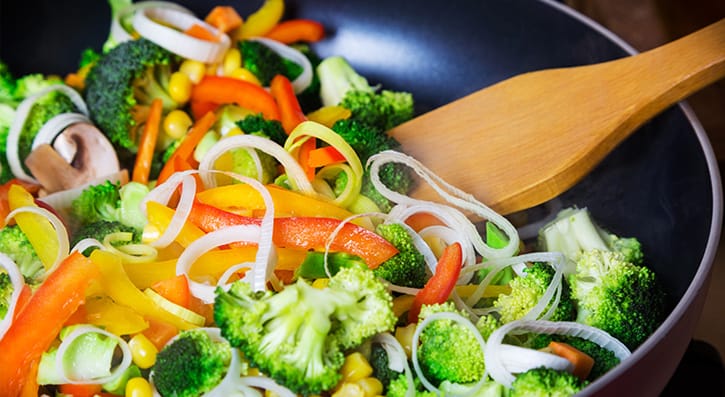Healthy Eating During Quarantine
0 min read
22 April 2020

Stress and uncertainty during the coronavirus pandemic might bring our worst eating habits to the surface. But there are ways to maintain a balanced diet at home with what you have in your freezer and cupboards. Proper nutrition is important for your health. Making good food choices, combined with regular exercise, can help you maintain a proper weight and more importantly fight of potential viruses.
TIPS FOR HEALTHY EATING DURING A CORONAVIRUS QUARANTINE
- Gather your favourite fruit and vegetables – these get your immune system in fighting shape.
- Power up your protein - keep up your strength and fight fatigue by eating lean protein.
- Stock up on soup and beans – you can make a pot of soup and then freeze in several small containers.
- Pack in probiotics – these are “good bacteria”.
- Be ready for comfort food cravings – avoid starchy, creamy, crunchy or sweet – not very healthy!
- Stay hydrated – fluids help thin mucus, flush out germs, and keep your digestion and immune system running smoothly.
- Find out more - 13 Essential tips for eating well during coronavirus self-isolation click here
HOW TO EAT HEALTHY ON A BUDGET
You don’t have to sacrifice your health, it’s all about making healthy choices on a budget.
- Create a meal plan and grocery list
- Buy what you can in bulk and in season - click here
- Have leftovers for lunch
- Swap cool drink and juice for water
- Choose plant-based proteins whenever you can
HOW TO EAT MINDFULLY
Practising mindful eating simply means being present when we eat - paying attention to it and being aware of it. It’s a powerful and easy way to learn how to be mindful, as it’s fun, helps us eat well and is easy to practise as we already eat several times a day! Start by practising one step on one snack for a few days, then try the next one. Eventually you can combine all five steps on a whole meal, and experience being fully mindful whilst you eat – it takes 21 days to form a habit so keep at it and it’ll come more naturally.
Step 1: When hunger strikes
When you are hungry, become aware of your body and notice a couple of breaths. What is your body telling you? Spend a couple of moments noticing the sensations that give you that message. No need to change them, just become aware of them and explore the feeling. Benefits: When you listen, your body will tell you if it is actually hungry and what it’s hungry for. Learning to accept and therefore tolerate hunger stops us from knee-jerk eating food that we don’t really need.
Step 2: Choosing what to eat
Look or think about the choices, becoming aware of what’s on offer. Notice all the factors at play – the different foods, what they’re made of, how they are prepared, how they smell, the cost. Notice the choice is yours, and what thoughts or feelings arise from each option, without trying to change them. Benefits: To stop and notice the foods on offer opens our eyes to the choices we make. It allows us to make informed choices that nourish us – whether that’s by making a wholesome choice or one that’s indulgent!
Step 3: Preparing your food
Take the time to be mindful as you prepare to eat. It might be as you are peeling back the paper as you walk along, sitting at your desk lifting the lid, or beginning to peel, chop and fry. It doesn’t matter where you are or what you’re eating – just notice the textures, sounds, smells and what everything looks like as your food is in front of you. Benefits: We eat with our eyes too and paying attention to the food you're preparing stimulates and focuses your body, ready for eating. It helps the body to prepare for what it’s about to do, so you’ll find your digestion and appetite signals working much more efficiently. If your mouth waters – you know you’re on track!
Step 4: Eating
The most fun bit! Start by having a good look at what you’re about to eat. Take note of the textures, shapes and colours, then, notice any smells and sounds. When you take a bite, notice the temperature, the texture and all the different tastes. Be aware of how the food feels on your fork or in your hand, then how it feels in your mouth. Notice your mouth chewing away, and your breathing as you go. Benefits: Being mindful when we are eating food allows the body to respond properly to what it’s doing. If you eat whilst worrying about your next meeting, the body is in stress mode and digestion is compromised. Eating mindfully also allows for the proper signals to be sent to the brain when we’re full, preventing us overeating.
Step 5 – After you’ve finished
When you’ve finished eating (or are having a break), become aware of your body. Again, noticing the breath is a helpful way to engage with yourself. Notice the feelings of fullness, or emptiness, any movement in your body or any tastes that linger. Benefits: Becoming aware of feelings after we’ve eaten allows the body to return to a resting state, which aids digestion. Much of our appetite comes from how full we’re accustomed to feeling, so bringing our attention to this can help interrupt habitual overeating.
Why not take 5 minutes and watch the Mindful Eating video - click here
Page Tags
SERCLatest News
Keep up with the latest from SERC



